Nassau County Police Department
| Nassau County Police Department | |
|---|---|
 | |
 Seal of the Nassau County Police Department | |
 | |
| Abbreviation | NCPD |
| Agency overview | |
| Formed | 1925 |
| Jurisdictional structure | |
| Operations jurisdiction | Nassau, New York, USA |
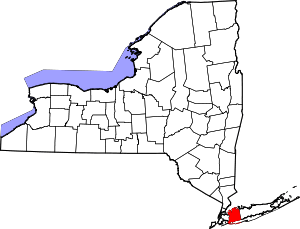 | |
| Map of Nassau County Police Department's jurisdiction. | |
| Size |
287 square miles (Land)[1] 166 square miles (Water) |
| Population | 1,334,544 |
| Legal jurisdiction | Nassau County, New York |
| General nature | • Local civilian agency |
|
| |
| Police Officers | 2,400 (2018)[2] |
| Police Commissioner responsible |
|
| Agency executive |
|
| Facilities | |
| Precincts | 7 |
| Website | |
| http://www.pdcn.org | |
The Nassau County Police Department is the law enforcement agency of Nassau County, New York.
History
In 1925, concerned about rising crime rates, the County Board of Supervisors voted to create the Nassau County Police Department, replacing a scattered system of constables and town and village police departments. (Some jurisdictions declined to join the police district, however, and maintain their own independent police forces to this day.) Consisting initially of Chief of Police (later Commissioner) Abram Skidmore, 55 officers and a fingerprint expert, the force grew to 450 officers by 1932 and reached 650 officers by the time Skidmore retired in 1945.
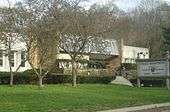
The expansion accelerated dramatically following World War II with the rapid suburbanization of the county. It reached 1,000 officers in six precincts by 1950. A seventh precinct was opened in 1955 and an eighth followed five years later. In the early 1970s, with crime and civil disorder in neighboring New York City and other cities a major concern, the force was boosted to its greatest strength, nearly 4,200 officers. Since then, it has declined to around 2,600, making it still one of the largest county police agencies in the United States.
In 1989 officers were equipped with 9mm Sig Sauer P226 semi-automatic pistols to replace older .38 Special revolvers.
Nevertheless, the department's reduced size has been a source of controversy, with the village of Mineola exploring the idea of seceding from the police district and establishing its own police force.[3] On Dec. 5th, 2006, however, the village's voters decisively rejected the proposal, 2936 to 1288.[4]
In October 2011, the Nassau County legislature voted on a budget that will have the effect of closing three of the eight precincts. In March 2012 the Levittown station was chosen to be the first to be reduced to a "Community Policing Center" followed by the 5th Precinct in Elmont, and 6th Precinct in Manhasset. The 5th Precinct has since reopened.[5]
The NCPD's guiding philosophy is that it is a "service-oriented" police department, promoting the concept of the community as client, and the police as provider. (For example, officers will come to a citizen's home to take a crime report or complaint, rather than ask the citizen to come to the precinct.) Sociologist James Q. Wilson used the Nassau department as the exemplar of this approach in his classic 1968 study, Varieties of Police Behavior.
Technology
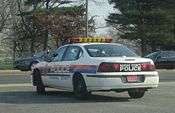
The department has historically been quick to embrace new technologies. The Marine Bureau began in 1933 with the gift of an 18-foot Chris Craft mahogany speedboat from the residents of Manhasset Bay. The Aviation Bureau followed a year later with the gift of a Stinson airplane from wealthy county residents. The aircraft was grounded by World War II, but the air unit was revived in 1968 with the purchase of four helicopters to assist in pursuits and medical evacuations. The Highway Patrol unit, which covers the Long Island Expressway and the Seaford-Oyster Bay Expressway and includes motorcycle officers, was founded in 1935. All police vehicles are now equipped with computer keyboards, and, since 1973, air conditioning.
In addition to these units, the department also maintains many features, such as a Detective Bureau, a police academy, a mounted unit, an arson/bomb squad, a hostage negotiation team, a citizen-based auxiliary police program, and an Emergency Services Unit (ESU), that are usually found only in the police departments of large cities. The department has also adopted its own system for computerized tracking of crime information known as NASSTAT, now called Strat-Com.[6]

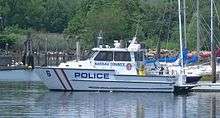
Traffic safety is a major department priority, given Nassau's relative lack of public transportation and its perpetually clogged roads and highways. A unique feature of the department is its Children's Safety Town, an actual village built to 1/3 scale that includes paved streets, two intersections equipped with traffic signals, an overpass, two tunnels, a simulated railroad crossing and 21 buildings. Managed by the department's Traffic Safety Unit, it allows the NCPD to teach traffic and bicycle safety to grade schoolers under controlled conditions.
In 1989, concerned about the increasingly heavy weaponry being carried by criminals, the NCPD was among the first police departments in the country to trade their venerable 6 shot .38 Smith & Wesson revolvers for the 15-round, nine-millimeter SIG P226 semi-automatic pistol. More recently, the department announced it is switching over to the SIG P229 and SIG P226, chambered for .40 S&W with the Double Action Kellerman (DAK) trigger and integral accessory rail as the new standard firearm. Also, officers are re-equipping with expandable batons to replace the straight wooden nightstick.
In 1995, the NCPD became the largest police department in the country to that time, and the first in New York State, to allow its officers to work a steady 10- or 12-hour shift, rather than a rotating 8-hour shift commencing at a different time each week.[7] In early 2007, the NCPD announced that 207 marked patrol vehicles would be equipped with Global Positioning System (GPS) devices, allowing "live" views of the location of all active units.[8]
In late 2006, the department undertook "Operation Gotcha,"[9] deploying a new technology that scans the license plate numbers of passing vehicles directly into a mobile crime computer, allowing the immediate apprehension of drivers operating vehicles with expired licenses, suspended registrations or with outstanding arrest warrants. The technology allows the scanning of literally thousands of plates in a single shift.
Vehicles
The police department in the 1990s used Ford Crown Victoria's and Chevrolet Caprices as their main patrol cars. In the 2000s they remained with the Ford Crown Victoria P71 until 2003.
In 2003, the department switched to the 2003-2005 Chevrolet Impala 9C1. The Ford Crown Victoria was still purchased, albeit in smaller quantities. The department favored the "CVPI" due to the rear-wheel drive and V8 configuration. The department switched back to the Crown Victoria in 2006. Few Impalas are still in service in 2018.
2006-2010 Dodge Charger's were tested for Highway patrol use. The Dodge Charger was a performance leader, however, due to maintenance costs, the department did not stick with them.
The department tried Chevrolet Tahoe's in 2010 and were given to certain sectors. The vehicle proved to be a strong patrol car with good all-weather capability. The Chevrolet Caprice 9C1 was tried out in 2014 and was given to precincts and highway patrol. Nassau County ended up switching to the Ford Utility Interceptor as their main choice. Today, the Ford Utility interceptor is the most widely used car in the fleet.
Rank structure
Promotion to the ranks of sergeant, lieutenant, and police captain, are made via competitive civil service examinations. Promotion to the ranks of detective, detective sergeant, detective lieutenant, detective captain, deputy inspector, inspector and chief are made at the discretion of the police commissioner.
| Title | Insignia |
|---|---|
| Police Commissioner | |
| Chief of Department | |
| Chief of Division | |
| Assistant Chief | |
| Deputy Chief | |
| Inspector | |
| Deputy Inspector | |
| Detective Captain Captain |
|
| Detective Lieutenant Lieutenant |
|
| Detective Sergeant Sergeant |
|
| Detective Police Officer |
Auxiliary Police
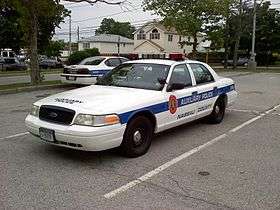
The Nassau County Auxiliary Police is a unit of the Nassau County Police Department. These volunteer police officers are assigned to 1 of 36 local community units and perform routine patrols of the neighborhood and provide traffic control for local parades, races, other community events and assist the Police Department as needed. Auxiliary Police officers are empowered to make arrests for crimes that occur in their presence.
Nassau County Auxiliary Police officers must attend and complete a 130-hour, 36-session training course,[10] which is taught by state-certified instructors at the Nassau County Police Academy. Emergency Medical Technician (EMT) training is also available to all officers after certain criteria is met. Basic academy training includes: peace officer powers, New York State Penal Law, hazardous materials awareness, baton training, blood-borne pathogens, basic first aid/CPR, traffic and pedestrian control, and response to critical incidents.
Auxiliary Police officers are certified by the NYS Division of Criminal Justice Services (DCJS) as "Peace Officers" and are registered in the NYS DCJS registry of peace officers.
Emergency Ambulance Bureau

In addition to police officers, the department also employs hundreds of civilian Police Medics (PMs) which consist of Critical Care Technicians (EMT-CC's) and Paramedics.
Unlike most jurisdictions, where emergency medical response and ambulance transport are functions performed primarily by the fire department, in Nassau, the police department and local volunteer fire departments share this responsibility. Nassau is one of the few police agencies in New York State that trains all of its police officers to provide emergency medical services to assist the Police Medics. Nassau Police ambulances are manned by gray & blue uniformed Police Medics rather than police officers.

The department operates 18-26 Demers Type I and Braun Type-III modular-style ambulances on any given day, each designated a 4 digit unit number 23xx. For frontline Ambulances, the final number matches the precinct the ambulance is assigned to. For example, an ambulance assigned to the fourth precinct would follow this model: 23x4. The third number is chosen at the discretion of headquarters and can be any single digit number, so long as an ambulance with that designation is not already in service. Spare ambulances do not follow this system. All ambulances are advanced life support ambulances and carry heart monitors, defibrillators, oxygen, trauma dressings and other vital equipment.
The NCPD Emergency Ambulance Bureau consists of 5 ranks: Police Medic, Police Medic Supervisor, Police Medic Coordinator, Police Medic Deputy Bureau Director, and Police Medic Bureau Director, in addition to Police Medic Cadets at the Police Academy. As Police Medics are civilian employees of the NCPD, they have no rank equivalency to sworn police officers, however the lowest rank ever allowed to oversee the bureau was a Deputy Inspector, and in more recent times the bureau was overseen by a full Inspector. At the present time, the bureau is overseen by the chiefs within the patrol division and is considered a part of the patrol division. The Bureau Director of the Emergency Ambulance Bureau has been described in the past to function similarly to an inspector or even a deputy chief.
The NCPD Emergency Ambulance Bureau covers over 60,000 calls per year with 22 units operating.
A small number of EAB personnel are designated "Tactical Medics," specially trained and equipped to operate with the NCPD's Bureau of Special Operations to rescue wounded officers and civilians under fire.
After finding the abandoned bodies of a number of newborn children, Nassau AMT Timothy Jaccard and several of his colleagues in the Emergency Ambulance Bureau founded the AMT Children of Hope Foundation,[11] to give these children proper funerals and dignified burials.
Civilian members
The Nassau County Police Department also employs School Crossing Guards, Communication/911 operators, Police Service Aids, Clerk/Typists, Mechanics and Public Security Officers.
Personnel issues
Nassau officers (along with the neighboring Suffolk County Police Department) have become known in recent years for their exceptionally high rate of pay, especially as compared with the nearby New York City Police Department. In July 2007, a state arbitrator awarded Nassau officers a substantial pay hike, bringing those with nine years seniority eventually to a top salary of $116,955 annually,[12] not counting benefits, overtime and night differential. If past practice is any guide, the increase will likely set a pattern to be matched and surpassed by the Suffolk County Police.
Many New York City Police officers apply for positions in the Nassau force because of this disparity.[13] Failure rates of NYPD officers in the Nassau Police Academy are about the same as non-police officer candidates. Typically, between one-third and one-half of the recruits in every Nassau police academy class are former city officers.[14] A police exam took place between Aug. 13-18, 2007.
Police pay has been a contentious issue in the county for well over a decade. In 2000, the state formed a financial oversight authority to monitor the county's budget. On Jan. 27, 2011, after several public warnings, the authority moved to take control of the county's finances.[15] Budgetary issues have curtailed hiring severely in the last decade. On May 17, 2013, a class of only 37 recruits was sworn into the police academy, the first class since 50 recruits entered in 2008 and 48 in 2004.[16]
Hiring on the Nassau force has also long been a bone of contention, with African-Americans, Hispanics and other groups, often supported by the U.S. Justice Department, claiming the hiring process is biased toward white males. The county has denied any intentional discrimination, and there have been repeated recruiting drives aimed at convincing more minorities to take the police exam, which itself has been repeatedly redesigned with the aim of making it easier. White candidates have disputed this, claiming the test is now biased against them.[17] These controversies have led to numerous lawsuits, which have repeatedly delayed hiring over the last two decades and account in part for the force's shrinking size.
Another major point of contention between the county government and the police union in recent years has been inadequate police academy training facilities. After being located for several years in a converted elementary school in Williston Park, the academy facilities were "temporarily" relocated for a decade in trailers on the grounds of the county jail in East Meadow. In May 2006, the Suozzi administration announced the academy would move into yet another converted school, this one in Massapequa, by the end of the year.[18] The first class of recruits to train in the new facility entered in early January 2008.
The department is headed by a civilian commissioner, appointed by the county executive. On January 24, 2018, County Executive Laura Curran appointed Patrick Ryder, the former commanding Officer of the Asset Forfeiture & Intelligence Unit, as Commissioner.[19] On February 26, 2018, after being unanimously confirmed by the Nassau County Legislature, Ryder was sworn in as Nassau County police commissioner.[20][21]
Notable cases
The Nassau County Police investigated the hunt for The Honeymoon Killers Raymond Fernandez and Martha Beck in the late 1940s,[22] the Weinberger kidnapping[23] of 1956 (on which the 2002 Robert De Niro film City by the Sea was very loosely based), the crash of Avianca Flight 52 in Cove Neck in 1990, the Joey Buttafuoco/Amy Fisher imbroglio, and the shootings committed aboard a Long Island Rail Road commuter train by Colin Ferguson in 1993. Among the NCPD's few large-scale, high-profile security events have been the 1998 Goodwill Games, which took place largely in Nassau County, and the third 2008 presidential debate, which took place at Hofstra University in Hempstead. Nassau officers also participated in the recovery effort at the World Trade Center site in September 2001.
Fallen officers
In the history of the Nassau County Police Department, 35 police officers have died while on duty.[24]
Equipment
- SIG Sauer P226 DAK and SIG Sauer P229 DAK both in .40 S&W- officers have their choice and both weapons replaced older 9mm SIG Sauer P226 pistols.
- SIG Sauer SIGM400
See also
References
- ↑ See, The World Almanac and Book of Facts, 2006 Edition, p. 535
- ↑ "Archived copy". Archived from the original on 2011-01-02. Retrieved 2010-09-13.
- ↑ Board of Trustees Rejects Bids for Police Study: Public Will Get to Vote on Possible Mineola Police This Year, Mineola American, August 18, 2006
- ↑ Residents Make Statement Against Village Police Department Archived 2007-09-30 at the Wayback Machine., Mineola American, December 15, 2006
- ↑ "Nassau County To Start Closing Down Police Precincts In May « CBS New York". Newyork.cbslocal.com. 2012-03-26. Retrieved 2016-09-15.
- ↑ "Nassau County Police Department". Police.co.nassau.ny.us. Retrieved 2016-09-15.
- ↑ McQuiston, John T. (January 9, 1995). "In Revising Police Shifts, Nassau Joins A U.S. Trend". The New York Times. Retrieved May 19, 2010.
- ↑ "GPS Devices Installed in Nassau Police Vehicles". The Northender. January 10, 2007. Archived from the original on 2007-10-08.
- ↑ "N.Y. police scan cars with high-tech cameras". Policeone.com. 2007-06-21. Retrieved 2016-09-15.
- ↑ "Nassau County Auxiliary Police". Pdcnaux.org. Retrieved 2016-09-15.
- ↑ "AMT Children of Hope Foundation". Amtchildrenofhope.com. Retrieved 2016-09-15.
- ↑ "Nassau Police force gets pay rate hikes". Newsday. July 2, 2007.
- ↑ Pierre-Pierre, Garry (October 8, 1995). "They're Tried, They're True, But How Long Do They Stay?". The New York Times.
- ↑ Kilgannon, Corey (May 22, 2007). "With High Pay, Long Island Police Jobs Draw Stampede". The New York Times. Retrieved May 19, 2010.
- ↑ "High Police Pay Fuels Nassau's Squeeze". The Wall Street Journal. Feb 4, 2011.
- ↑ "Nassau police department swears in 37". Newsday. May 17, 2013.
- ↑ "Quota Hires in Blue". The Weekly Standard. April 14, 1997. Archived from the original on 2006-11-10.
- ↑
- ↑ "Laura Curran taps Patrick Ryder as Nassau Police commissioner". Newsday. 2018-01-24.
- ↑ "Patrick Ryder sworn in as Nassau police commissioner". Newsday. 2018-02-26.
- ↑
- ↑ "Archived copy". Archived from the original on 2010-09-17. Retrieved 2010-09-28.
- ↑ "Archived copy". Archived from the original on 2010-06-09. Retrieved 2016-07-28.
- ↑ "Nassau County Police Department, New York, Fallen Officers". Odmp.org. Retrieved 2016-09-15.